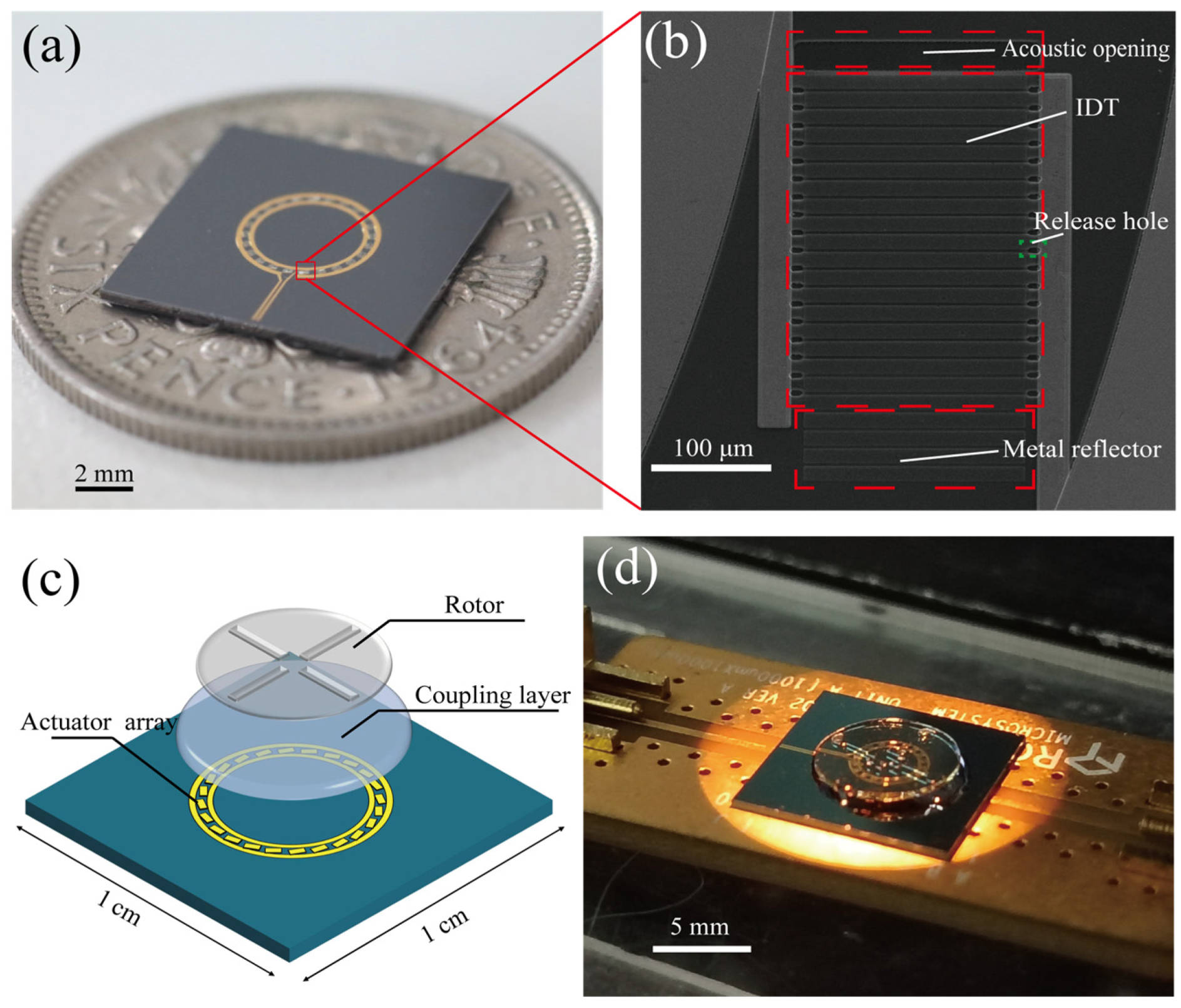Low-Voltage High-Frequency Lamb-Wave-Driven Micromotors
Abstract
:1. Introduction
2. Materials and Methods
3. Results
4. Discussion
5. Conclusions
Supplementary Materials
Author Contributions
Funding
Data Availability Statement
Acknowledgments
Conflicts of Interest
References
- Meng, G.; Zhang, W.-M.; Huang, H.; Li, H.-G.; Chen, D. Micro-Rotor Dynamics for Micro-Electro-Mechanical Systems (MEMS). Chaos Solitons Fractals 2009, 40, 538–562. [Google Scholar] [CrossRef]
- Liu, W.; Zhang, W.; Chen, W. Simulation Analysis and Experimental Study of the Diamagnetically Levitated Electrostatic Micromotor. J. Magn. Magn. Mater. 2019, 492, 165634. [Google Scholar] [CrossRef]
- Zhang, W.; Meng, G.; Zhou, J. Electrostatic Micromotor and Its Reliability. Jixie Qiangdu/J. Mech. Strength 2005, 27, 50–56. [Google Scholar] [CrossRef]
- Tian, Y.; Zhang, Y.-L.; Ku, J.-F.; He, Y.; Xu, B.-B.; Chen, Q.-D.; Xia, H.; Sun, H.-B. High Performance Magnetically Controllable Microturbines. Lab Chip 2010, 10, 2902. [Google Scholar] [CrossRef] [PubMed]
- Nana, B.; Yamgoué, S.B.; Tchitnga, R.; Woafo, P. Dynamics of a Pendulum Driven by a DC Motor and Magnetically Controlled. Chaos Solitons Fractals 2017, 104, 18–27. [Google Scholar] [CrossRef]
- Uran, S.; Bratina, B.; Šafarič, R. A Microfluidic Rotational Motor Driven by Circular Vibrations. Micromachines 2019, 10, 809. [Google Scholar] [CrossRef] [PubMed]
- Jiang, C.; Wu, X.; Lu, D.; Xu, Z.; Jin, L. Contact Modeling and Performance Evaluation of Ring Type Traveling Wave Ultrasonic Motors Considering Stator Teeth. Ultrasonics 2021, 117, 106518. [Google Scholar] [CrossRef] [PubMed]
- Kurosawa, M.K. State-of-the-Art Surface Acoustic Wave Linear Motor and Its Future Applications. Ultrasonics 2000, 38, 15–19. [Google Scholar] [CrossRef] [PubMed]
- Zheng, L.; Chen, L.; Huang, H.; Li, X.; Zhang, L. An Overview of Magnetic Micro-Robot Systems for Biomedical Applications. Microsyst. Technol. 2016, 22, 2371–2387. [Google Scholar] [CrossRef]
- Chen, Y.; Chen, D.; Liang, S.; Dai, Y.; Bai, X.; Song, B.; Zhang, D.; Chen, H.; Feng, L. Recent Advances in Field-Controlled Micro–Nano Manipulations and Micro–Nano Robots. Adv. Intell. Syst. 2022, 4, 2100116. [Google Scholar] [CrossRef]
- Gu, H.; Zhang, S.; Cheng, L.; Ma, D.; Zhou, F.; Chen, Z.; Shui, X. Study on Non-Contact Linear Motors Driven by Surface Acoustic Waves. Sens. Actuators A Phys. 2009, 155, 163–167. [Google Scholar] [CrossRef]
- Glass, N.R.; Shilton, R.J.; Chan, P.P.Y.; Friend, J.R.; Yeo, L.Y. Miniaturized Lab-on-a-Disc (MiniLOAD). Small 2012, 8, 1881–1888. [Google Scholar] [CrossRef]
- Zhang, H.; Xu, X.-D.; Cheng, L.-P.; Zhang, S.-Y. Experimental Studies of a New Type of Non-Contact Rotary Motors Driven by Surface Acoustic Waves. Sens. Actuators A Phys. 2019, 297, 111524. [Google Scholar] [CrossRef]
- Tan, M.K.; Siddiqi, A.; Yeo, L.Y. A Facile and Flexible Method for On-Demand Directional Speed Tunability in the Miniaturised Lab-on-a-Disc. Sci. Rep. 2017, 7, 6652. [Google Scholar] [CrossRef]
- Yeo, L.Y.; Friend, J.R. Ultrafast Microfluidics Using Surface Acoustic Waves. Biomicrofluidics 2009, 3, 12002. [Google Scholar] [CrossRef] [PubMed]





Disclaimer/Publisher’s Note: The statements, opinions and data contained in all publications are solely those of the individual author(s) and contributor(s) and not of MDPI and/or the editor(s). MDPI and/or the editor(s) disclaim responsibility for any injury to people or property resulting from any ideas, methods, instructions or products referred to in the content. |
© 2024 by the authors. Licensee MDPI, Basel, Switzerland. This article is an open access article distributed under the terms and conditions of the Creative Commons Attribution (CC BY) license (https://creativecommons.org/licenses/by/4.0/).
Share and Cite
Wang, Z.; Wei, W.; Zhang, M.; Duan, X.; Li, Q.; Chen, X.; Yang, Q.; Pang, W. Low-Voltage High-Frequency Lamb-Wave-Driven Micromotors. Micromachines 2024, 15, 716. https://doi.org/10.3390/mi15060716
Wang Z, Wei W, Zhang M, Duan X, Li Q, Chen X, Yang Q, Pang W. Low-Voltage High-Frequency Lamb-Wave-Driven Micromotors. Micromachines. 2024; 15(6):716. https://doi.org/10.3390/mi15060716
Chicago/Turabian StyleWang, Zhaoxun, Wei Wei, Menglun Zhang, Xuexin Duan, Quanning Li, Xuejiao Chen, Qingrui Yang, and Wei Pang. 2024. "Low-Voltage High-Frequency Lamb-Wave-Driven Micromotors" Micromachines 15, no. 6: 716. https://doi.org/10.3390/mi15060716




